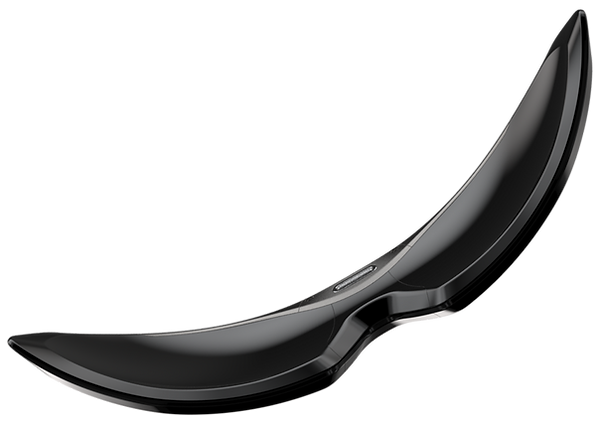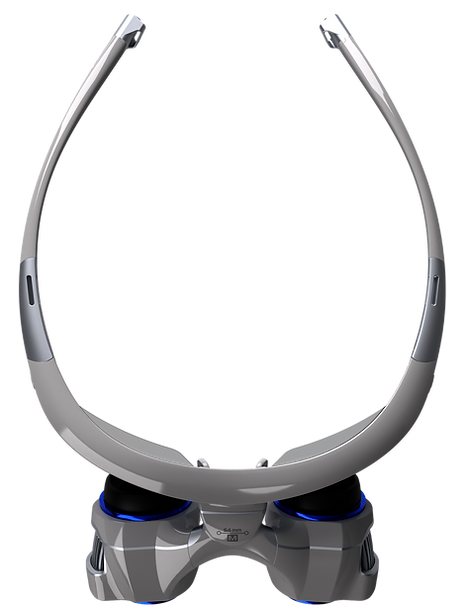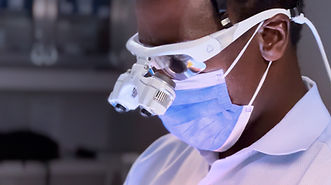

DESIGN
I've held a variety of team and project leadership roles, bringing practical experience that includes 10 years of hardware product development and 15 years of digital media product development, and a strong sense of aesthetics underlying everything I do.
Below are some examples of my recent efforts, from industrial design to software UI design.
CASE STUDY
1
XR Visor Industrial Design
2015 - 2022
Project Overview
-
As mentioned in the Engineering section, this Mixed Reality headset is the flagship product of my first startup, FYR Inc. I originally conceived of this device and its operating principles during my time with the Skunk Works® at Lockheed Martin as a means to provide fast, retinal quality MR to pilots of high-performance aircraft, improving situational awareness by spanning their entire field of view while minimizing eye strain and fatigue.
-
In cooperation with Lockheed Martin following years of internal R&D, we launched FYR in 2019 to commercialize the technology — a rare emergence of Skunk Works® innovation into the public sector.
-
I wore many hats on this project, beginning with the very first conceptual proof of concept sketches in 2015. Throughout the project I handled all industrial design, optomechanical design, electromechanical design, mechanical assembly, prototyping, and manufacturing. Below is more information on my industrial design work.
Project Vision & Design Objectives
-
Design a slim, lightweight headset approximating the form factor of wrap-around sunglasses
-
Extend the virtual imagery across peripheral vision, spanning as much of the visual field as possible
-
Ensure the design adheres to all electrical, optical, and mechanical requirements
-
Visor unit must be removeable from Frame for mounting with other headgear (helmets, face masks, etc.)
-
Continue and elevate the FYR brand through consistent styling, colors, materials, and finishes


Anthropometrics & Ergonomics
-
For reconfiguration with other mounting platforms, I designed the Visor unit as a self-contained device with a common magnetic pogo-pin connection port
-
The Visor can be securely fastened to the frame with a quick release mechanism, allowing for convenient dismounting and remounting to other headgear such as flight helmets
-
Full-field wrap-around vision is accomplished through tiling 88 individual Facets (44 for each left and right Eyepiece)
-
The edges of the Visor are tapered to reduce the overall thickness and weight
-
A central cavity for primary driving electronics and additional sensors lies above the nose, between the Eyepieces
-
The Frame for common use is tethered to a hip-mounted External Power & Computing Unit (EPCU) to help free the head from additional battery and processing weight
-
An outward-facing multicolor LED array provides activity and status feedback
-
The device is automatically activated by inward-facing proximity sensors when worn
Industrial Design
Selected product shots and design details
(rendered using Arnold in Maya)


CASE STUDY
2
XR Loupes Industrial Design
2022 - 2024
Project Overview
-
As mentioned in the Engineering section, this light field passthrough Mixed Reality headset is the main product of my most recent startup, FYR Medical. The device connects to surgical navigation platforms to provide spine surgeons with a virtual view into the patient's anatomy even before an incision is made.
My Role & Responsibilities
-
All mechanical and industrial design
-
Coordinating with surgeon advisors to capture and represent the voice of the customer, ensuring the design adequately meets all user needs for ergonomics, handling, storage, and performance
Project Vision & Design Objectives
-
Design a slim, lightweight headset approximating the form factor of surgical loupes
-
Account for the wide range of human adult head / face shapes and interpupillary distances
-
Ensure the design adheres to all electrical, optical, and mechanical requirements
-
Headset must be collapsible to fit inside a small case, comparable to conventional surgical loupes
-
Continue and elevate the FYR brand through consistent styling, colors, materials, and finishes




Anthropometrics & Ergonomics
-
To maximize adaptability in terms of form and fit, I divided the headset assembly into modular components that can be swapped for different configurations
-
Each left and right Eyepiece is a standalone unit that can connect to a Bridge
-
There are five different Bridge widths accounting for different IPDs
-
Every Bridge is angled such that left and right optical axes converge at a common 0.5 m working distance (can be further customized per user if necessary)
-
Each Bridge can be connected to a Frame which is worn by the user
-
There are two different Frame sizes to fit both large and small head circumference (can be further customized per user if necessary)
-
Both Frames have flexible Arms that can be flexed outward without damage
-
The Arms have slots for two optional head straps to keep the headset securely in place and provide some additional weight relief for long duration surgical cases
-
The Arms can be folded inward to collapse the Frame, similar to typical glasses
Industrial Design
Selected product shots and design details
(rendered using Cycles in Rhinoceros)

CASE STUDY
3
XR Loupes Software UI Design
2024 - 2025
Project Overview
-
To operate the XR Loupes headset (above), the surgeon relies on a scrub tech to control all operating parameters during pre-op and intra-op phases in the OR. This includes setting or changing everything from the view magnification to the rendering style of the CT or MRI volume.
My Role & Responsibilities
-
Defining the overall UX reference software functionality and vision
-
Designing the GUI for all components, controls, and modules of the host software app
-
Directing and managing a team of developers (both internal staff and external contractors) to implement the fully functional prototype software, written primarily in C++ / OpenGL

Project Vision & Design Objectives
-
Design the GUI for a reference software app that controls the XR Loupes headset and interfaces with the host navigation platform


Design Requirements
-
The app interface should fit on a standard 1920 x 1080 HD monitor, providing intuitive controls for all view settings, user preferences, and operating task functions
-
Create a surgeon login and profile settings page to store user-specific configuration details and preferences
-
Display the real-time view of what the surgeon sees in each Eyepiece, as well as the views from both tracking cameras
-
Integrate interactive, physically based ray-marching volume rendering to visualize patient anatomy within the surgeon's view
-
Provide diagnostic data from the headset to ensure electrical stability and optimal performance
-
Track the surgeon's view angle and head rotation for reference and ergonomic feedback (to prevent neck strain, etc.)
-
Design controls and control layouts for all color correction, view magnification, and mixing of real-world vs. virtual imagery
-
Allow selection of preferred render styles and immersion modes, including AR, VR, and MR operating modes
UI Design
Selected product screen layouts and control modules
(captured from a run-time demo session using anonymized DICOM data in lieu of a live patient)























